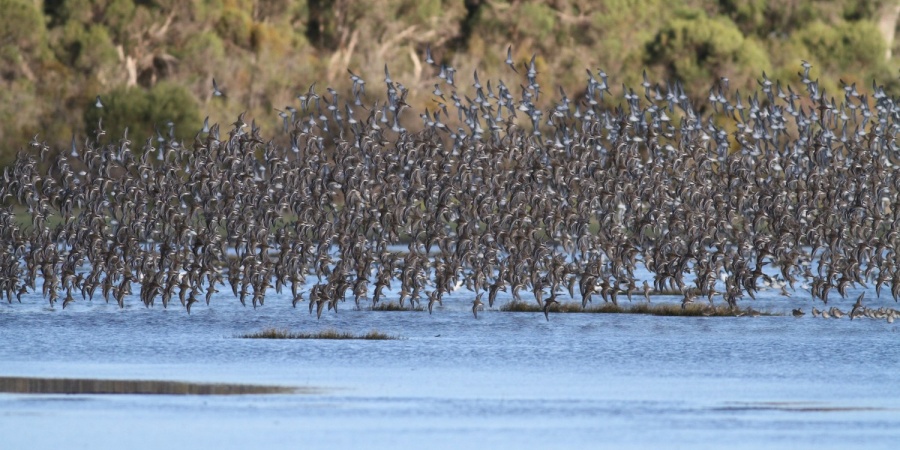
Migratory waders taking flight off Lake Mclarty. Photo by Bob Paterson
Migratory waterbirds include species such as plovers, sandpipers, stints, curlews and snipes.
These incredible birds make round trip migrations of up to 26,000 kilometres each year between their summer breeding grounds in the northern hemisphere and their feeding areas in the south. These trips are made in several weeks, with brief stops at staging sites along the way to rest and refuel for the next leg of their journey.
The corridor through which these waterbirds migrate is known as the East Asian - Australasian Flyway.
- It extends from within the Arctic Circle, through east and south-east Asia, to Australia and New Zealand.
- Stretching across 22 countries, it is one of eight major waterbird flyways recognised around the globe.
At least two million migratory waterbirds visit Australia each year during our summer:
- at least 36 species of migratory waterbirds visit Australian wetlands each year
- a further 16 species occasionally visit Australia.
- another 15 species—at least 1.1 million birds—permanently live in Australia.
In about September each year, hundreds of thousands of migratory waterbirds begin to arrive and inhabit wetlands of Western Australia's north- and south-west, feeding mostly on the invertebrates that live in shallow water in drying wetlands, tidal flats and salt marshes. Common species include the red-necked stint, curlew sandpiper, sharp-tailed sandpiper, bar-tailed godwit and greenshank.
Conserving migratory waterbirds
Migratory waterbirds and their habitats are internationally protected because:
- land use activities such as agriculture, mining and urban development can impact on wetlands visited by migratory waterbirds
- along their migratory route, the birds stop at many different wetlands. Because disturbance at one site affects the entire network of wetlands used by these birds, it is important to protect wetlands all along the flyway
Asia-Pacific Migratory Waterbird Conservation Strategy
Australia, with other countries, has developed regional strategies to help protect the habitats of migratory waterbirds, the most recent of which is the East Asian-Australasian Flyway Partnership.
Its goal is to recognise and manage a network of important wetland sites to ensure the long-term conservation of migratory shorebirds along the flyway.
Nineteen of these important sites are in Australia, four in Western Australia within Ramsar Sites and managed by the department:
International agreements on migratory waterbird conservation
Australia is a signatory to three international agreements that protect and recognise the importance of conserving migratory birds and their habitats:
- Japan-Australia Migratory Bird Agreement (JAMBA)
- China-Australia Migratory Bird Agreement (CAMBA)
- Republic of Korea-Australian Migratory Bird Agreement (RoCAMBA)
Species of migratory birds that occur in Australia, Japan, China and the Republic of Korea are listed under the three agreements.
The migratory birds species are also protected:
- under the Environment Protection and Biodiversity Conservation Act 1999 (Commonwealth) through the Wildlife Conservation Plan for Migratory Shorebirds
- through the Convention on Migratory Species
Related resource - Shorebirds and seabirds of the Pilbara coast and islands
The Pilbara coast and islands, including the Exmouth Gulf, provide important refuge for a number of shorebird and seabird species. For migratory shorebirds, sandy spits, sandbars, rocky shores, sandy beaches, salt marshes, intertidal flats and mangroves are important feeding and resting habitat during spring and summer, when the birds escape the harsh winter of their northern hemisphere breeding grounds.



